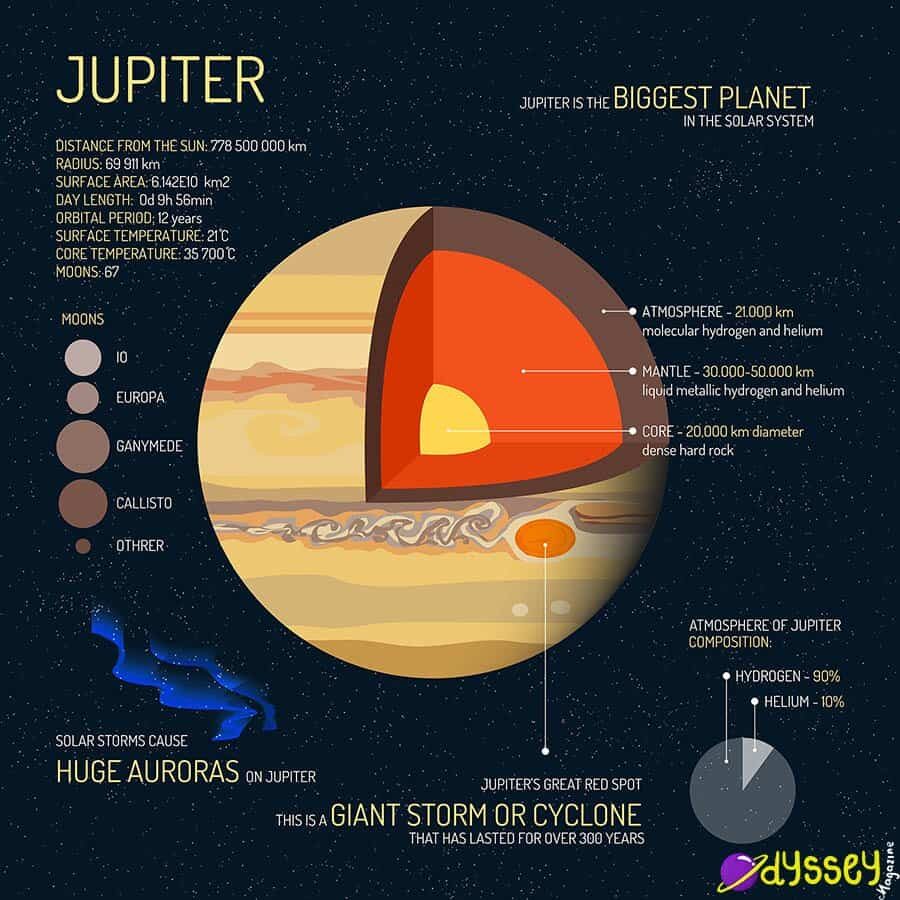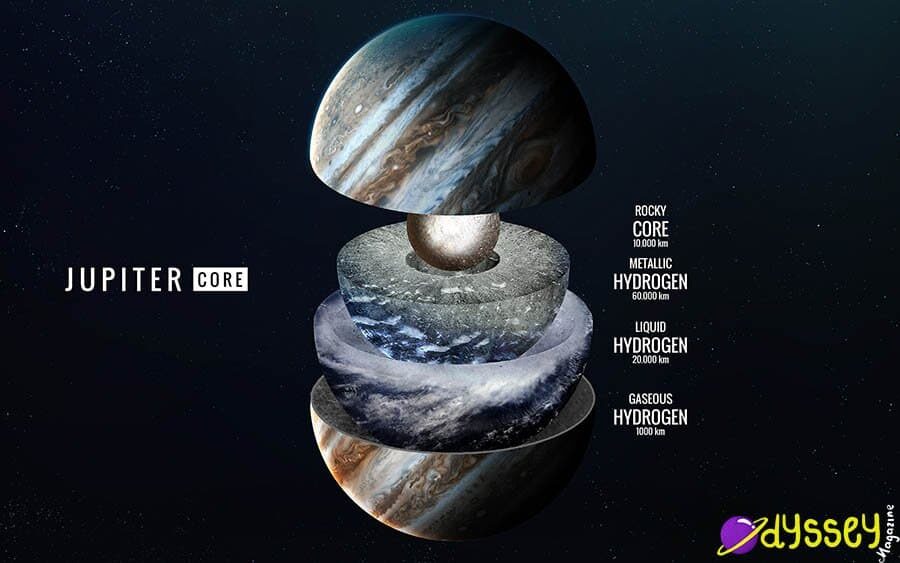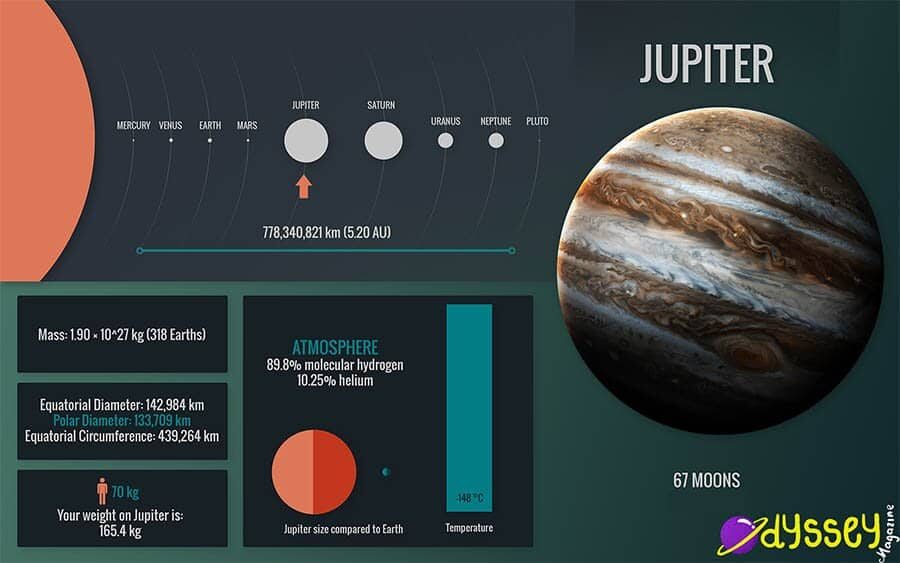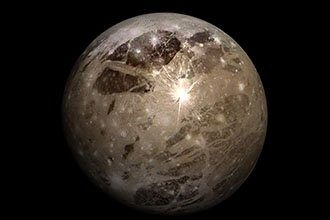24 Jupiter Facts | Impressive Facts about the planet Jupite
Jupiter is known as the largest planet in our solar system and the closest to us of the gas giants. It’s one of the brightest objects in our solar system, and it’s been the focus of many different spacecraft missions over the last century. It takes its name from the Roman equivalent of Zeus, likely due to its size. So, let’s take a look at some Jupiter facts to find out more about how this planet works.

- Jupiter is the fifth planet from the Sun, behind Mercury, Venus, Earth and Mars.
- Jupiter has a very large radius of 43,440.7 miles (69,911km) – this makes it the largest of the planets in our solar system.
- Jupiter is ELEVEN times bigger than the Earth, and TWENTY times bigger than Mars!
- The color of Jupiter is a mixture of browns, yellows, whites, reds and some orange. However, it’s surface color changes with changes in the atmosphere.
- Jupiter is 484 million miles (778 million kilometers) away from the Sun. To compare, Earth is less than 100 million miles away.
- One day on Jupiter is only 9 hours and 56 minutes long – this is the shortest of any planets in our solar system.
- Whilst a day is shorter than on Earth, a year on Jupiter is approximately to 11.86 years on Earth – this is the amount of time it takes to orbit the Sun.
- Jupiter orbits the Sun at a pace of 29,236 miles per hour (47,05km per hour).
- Unlike the terrestrial planets, the gravity of Jupiter actually make us heavier – 2.4x heavier. So a 200lb man would weigh 480lbs on Jupiter.
- Like the other planets, Jupiter does not orbit the Sun in a circle, but more of an oval (ellipse) pattern.
- Jupiter takes its name from the Roman King of the Gods. The Greek equivalent of Jupiter is Zeus.
- Jupiter is one of the four gas planets in our solar system, along with Saturn, Uranus and Neptune.
Depending on who you ask, you will get different answers to what Jupiter’s core consists of. Many think that its inner core is solid, likely made up of rocks, however this isn’t proven. However, missions like Juno have helped us to understand the composition of this planet a little better. It’s likely that outside of a small rocky core, there is a large amount of metallic hydrogen.

Outside of this thick layer of metallic hydrogen is a layer of liquid hydrogen, however there is no clear boundary between gas a liquid. Outside of this is a thin layer of gaseous hydrogen, which is coated by clouds made from ammonia ice and water vapour.
So the clouds that surround Jupiter constantly are made from ammonia crystal, but how do they get there? Well, these clouds are likely formed from the storms that reign across the surface of the planet. These storms then cause the upwards motion of the air, which forms clouds.

Along with the storms on Jupiter, there is a lot of lightning also. This lightning is estimated to be more than 100x more powerful than the lightning on the Earth. In recent years, we’ve actually learnt a lot more about the lightning on Jupiter due to NASA’s spacecraft mission, Juno.
It’s actually quite different to the lightning that we have on Earth too. Much of this is because there’s a small amount of ammonia in the atmosphere there, which means that the water is more resistant to freezing. This creates large “mushballs” in their storms, which is essentially like giant hailstones.
At the time of writing, Jupiter has 79 confirmed moons. However, this is likely to increase soon, as more moons are discovered amongst both Jupiter and Saturn.
We refer to the four largest moons of Jupiter as the Galilean moons. This is because they were discovered by Galileo Galilei back in 1610. These moons are;

Ganymede is the largest moon in our solar system. The name is taken from the Greek hero, known as the most beautiful mortal.

Callisto is the second largest moon of Jupiter, and third largest overall. It takes it’s name from one of Zeus’s nymph lovers.

Io takes it’s name from a priestess and another one of Zeus’s lovers. It has the highest density of any moon.

Europa is a similar size to Earth’s moon, and takes it’s name from the Phoenician princess (who was, of course, one of Zeus’s lovers).
These are just 4 of the moons of Jupiter, but they are typically the main moons that people refer to. There are more of Jupiters moons to explore, like Metis and Amalthea.
- Jupiter is made up primarily of Hydrogen, with around 10% of Helium gas too.
- There is no free oxygen on Jupiter, so humans would need their own supply if we ever visited.
- Because of this, it’s impossible for us to “land a spacecraft” on Jupiter like we can with the terrestrial planets, like Mars.
- It’s thought that the inner core of Jupiter might actually be rocky, but this isn’t proven and something we aren’t sure of yet.
- Jupiter has an average temperature of around -145°, however the center of Jupiter is much hotter than this.
- Jupiter has a race with Saturn for the most moons. Currently, Jupiter has 79 moons, whilst Saturn recently overtook Jupiter’s moon count with 81.
- One of Jupiter’s moons is Ganymede, which is the largest moon in the solar system, and the 9th largest object after the 8 planets.
- We divide the rings of Jupiter, known as the Jovian ring system, into 4 systems; the Halo ring system, the Main Rings system, the Amalthea gossamer ring system and the Thebe gossamer ring system.
- Sometimes astronomers refer to Jupiter as a failed star – this is because it has the same elements as the Sun, Hydrogen and Helium.
- The red spot on Jupiter is known as the biggest storm in our solar system. This storm has existed for hundreds of years, and reached speeds of over 270mph.
- Jupiter has a large magnetic field that is particularly intense, as it is more than 14x stronger than the Earth’s magnetic field.
- After the Moon and Venus, Jupiter is the next brightest object in our solar system. This means there are actually time where you can see Jupiter with no telescope.
The red spot that Jupiter is well known for is actually a giant storm. We know that is was first identified in the early 1800s, but some writings link it back to the 1600s, so we’re not sure how long it’s been in existence. This storm is more than twice the size of the Earth, and still continues due to the fact that Jupiter is a gas planet, and there’s no friction with it’s surface.
One of the main problems that we have with understanding what Jupiter is made of of because it has no solid surface for us to land a spacecraft on. The crust of Jupiter is made up of gas, so we cannot send anything to land on Jupiter to learn more information.
Jupiter is much bigger than any other planet in our solar system. You could easily fit all of the other planets into Jupiter. Jupiter is more than double the size of every other planet, excluding Saturn.
Although Jupiter is bigger than any other planet in our solar system, it’s nowhere near the size of the Sun. The Sun is roughly about 10x the size of Jupiter. Many astronomers look at Jupiter as a “failed star”, with theories that it could have been as big as the Sun or even larger.
Jupiter cannot support life as we know it, as it doesn’t have the environment for life to survive. However, there are theories that we could live on one of Jupiter’s moons, with Europa maintaining a lot of interest due to it’s outer layer of water.
These are just some facts about the biggest planet and one of the brightest objects in our solar system. The colored clouds of Jupiter make it appear very visually appealing, but when you look beneath the surface it’s primarily made up of gas and liquid hydrogen. If you have any question about Jupiter, please leave them below.